2005 VOLKSWAGEN GOLF child restraint
[x] Cancel search: child restraintPage 14 of 444
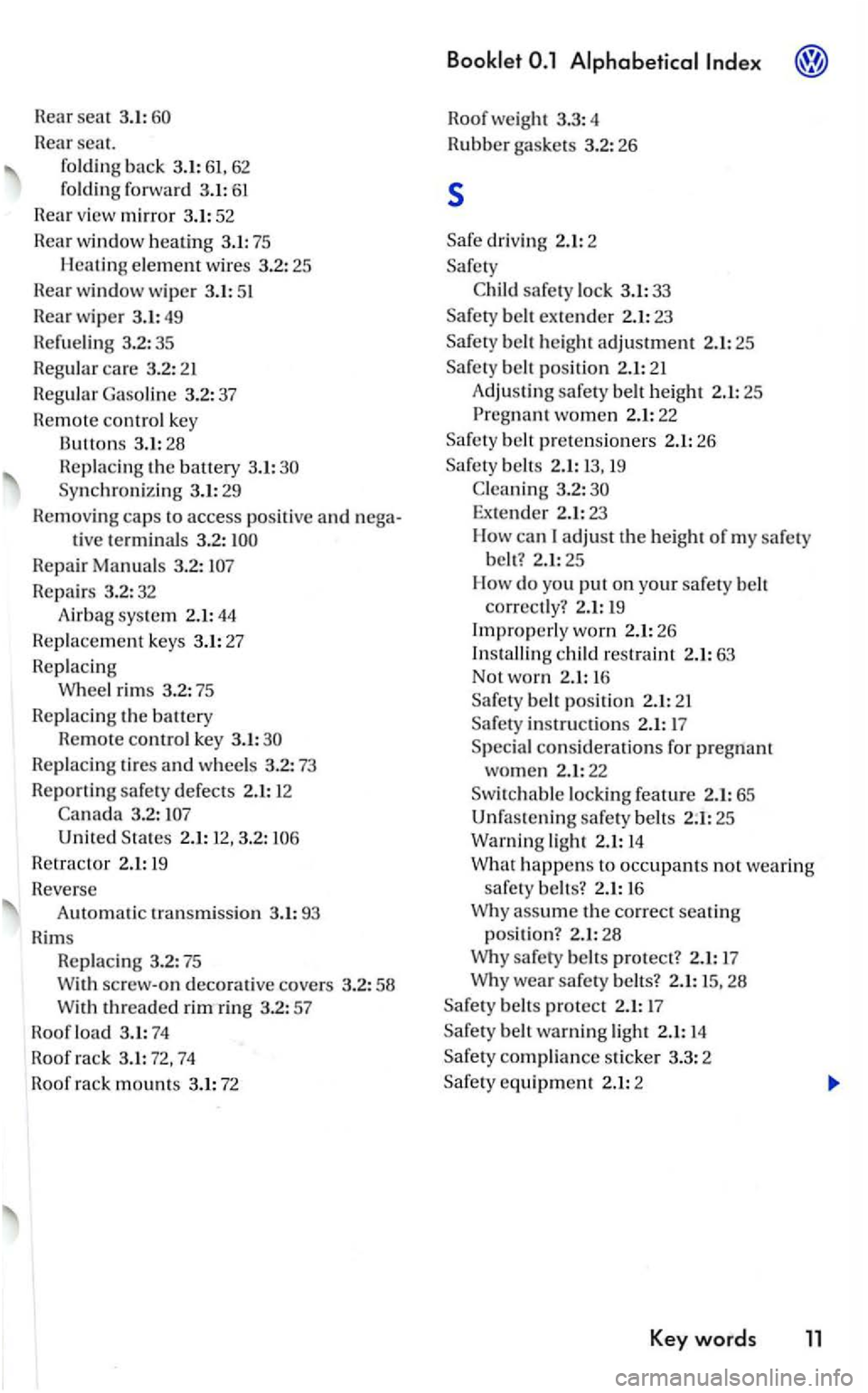
seat 3. 1:
seal.
foldin g back 3.1:61, 62
fold ing forward 3.1: 61
v iew mirror 3.1:52
window heating 3.1: 75
Heating wires 3.2:25
window wiper 3. 1:51
H
earwipe r 3.1:49
3.2: 35
care 3.2:2 1
contro l key tons 3.1: 2 8
Heplaci ng th e bauery 3.1: Synchroni zing 3.1: 29
H emoving caps to acce ss positiv e and tive te rminal s 3.2:
2.1: 12,3.2: 106
R etra ct
or 2.1: 19
R everse
A utomatic transm ission 3.1:93
Hims
R
epl aci ng 3.2: 75 With screw-on decorative cove rs 3.2: 58
With threaded rim ring 3.2:57
Hoof l
oad 3.1: 74
we ight 3.3: 4
Rubb er ga sket s 3.2:
26
s
driv in g 2.1: 2
Sa fety
C hild
safet y lock 3.1: 33
Sa fe ty belt ex te
nder 2.1:23
b elt height adjustment 2.1:25
belt pos ition 2.1:21
Adju sting safe ty
belt height 2.1:25
Pr eg nant
women 2.1: 22
Sa fe ty belt pre tension ers 2.1:26
Sa fety belt s
2.1: 13, 19
C leaning 3.2:
Extende r 2. 1: 23
Ho w ca n I adjust the height of my safety
belt? 2.1: 25
How
do yo u pu t on your safety belt correc tly? 2.1 : 19
Improp erly worn 2.1:26
child restraint 2.1:63
N ot
worn 2.1: 16
belt positi on 2.1: 2 1
instru ction s 2.1: 17
S p ec ial c
onsiderations for pregnant women 2.1: 22
Swi tc h able lo cking feature 2.1: 6 5
Unfa ste
ning s afety be lt s 2.1:2 5
Warning lig ht 2.1: 14
What happens to occ upants not wearing
safe ty be lts? 2.1: 16
Why assume
the correct seatin g
po sition ? 2.1:28
Why saf e ty belt s protect ? 2. 1: 1 7
Why wear safety belt
s? 2.1: 15, 28
Safe ty belts pro tect 2.1: 17
b elt warning ligh t 2.1: 14
Safety compliance sticke r 3.3: 2
Key words 11
Page 15 of 444
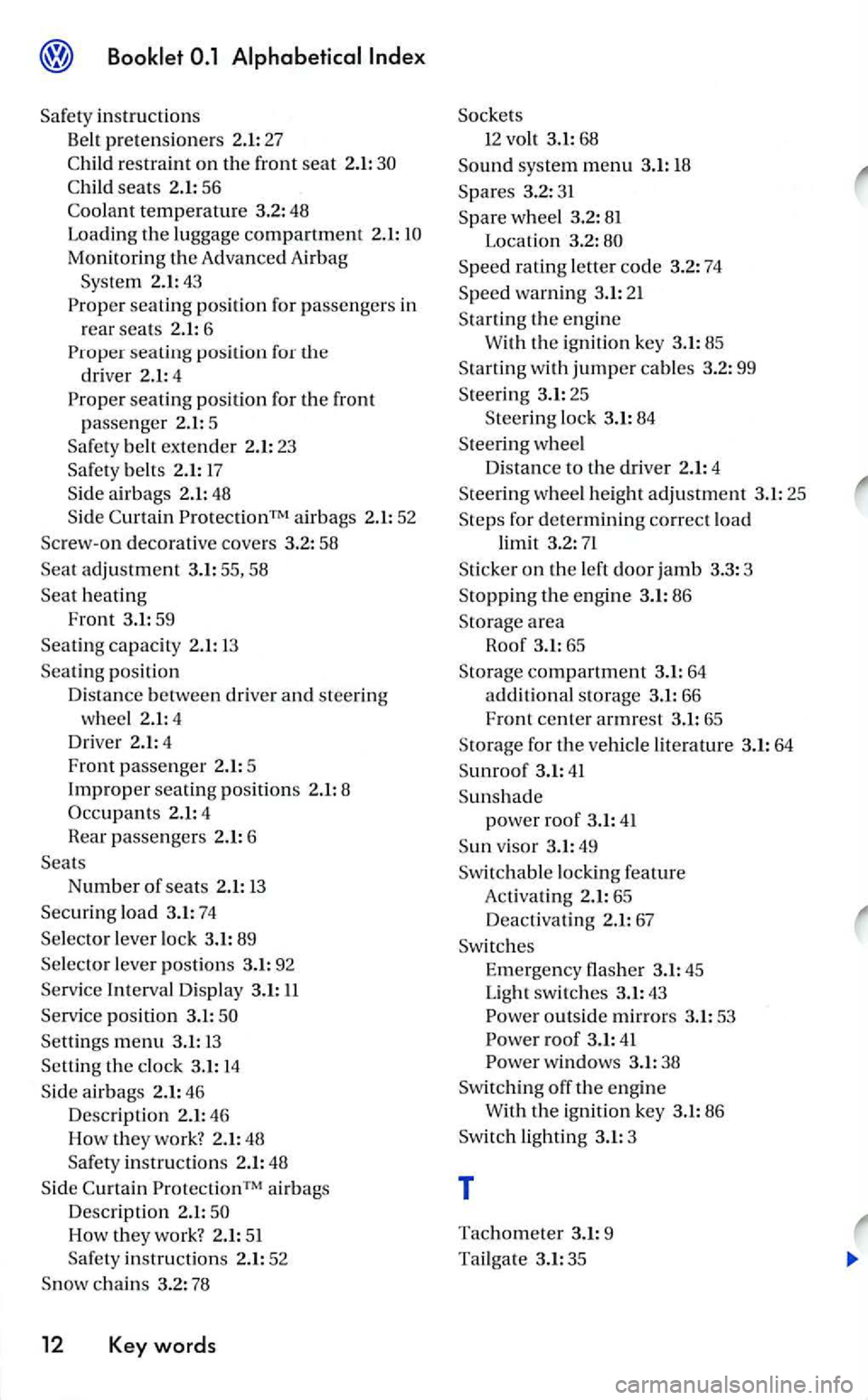
Safety instructions
Belt pretensioners 2.1: 27
Child restraint on the front seat 2.1:
Child seats 2.1 : 56
Coolant tempera ture 3.2:48
Loading
the lu ggage compartment 2.1:
seating position for passengers in
r
ear seat s 2.1: 6 seating position for
driver 2.1: 4
seating position for the front
passenger 2.1: 5
Safety belt extender 2.1: 23
Sa fet y
belts 2.1: 17 S id e airbag s 2.1: 48
Side Curtain ProtectionTM airbags 2.1: 52
Screw-on decorati ve covers 3.2: 58
Seat adjustment 3.1: 55, 58
Seat heating
Front 3.1:
59
Seating ca pacity 2.1: 13
Sea ting
position
Di s
tance between driver and ste erin g
w
hee l 2.1:4 Dr iver 2.1: 4
Fron t passen ger 2.1: 5 Improper seatin g position s 2.1: 8
Speed rating le tter code 3.2: 74
Speed warning 3.1: 21
Starting th e engine W ith the ig nition key 3.1:85
S tartin g
with jumper cables 3.2: 99
Stee rin g 3.1: 25
S
teering lock 3.1: 84
S te ering
wheel
Di s
tance to the driver 2.1: 4
Steerin g wheel height adjustment 3.1: 25
S
teps for determining co rrect load limit 3.2: 71
Sticker on th e left door jamb 3.3 : 3
Stopping the en gine 3.1:8 6
Sto rage
area
Roof 3.1:65
S torage
compartment 3.1: 64
additional sto rage 3.1: 66
Front center armrest 3.1: 65
S torage for
the vehicle literature 3.1: 64
Sunroof 3.1: 41
Sunshade
power roof 3.1:41
Sun viso r 3.1:49
Sw itch
able loc king feature
Activatin g 2.1: 65
D
eacti va tin g 2.1: 67
Sw itches Em ergency flasher 3.1: 45
Light swit ches 3.1: 43 outside mirrors 3.1: 53 ro of 3.1:41 windows 3.1: 38
Sw itching off the engin e
W ith the ignit ion key 3.1: 86
Sw itch
lig htin g 3.1: 3
T
Tachometer 3.1: 9
Ta
ilga te 3.1:35
Page 93 of 444
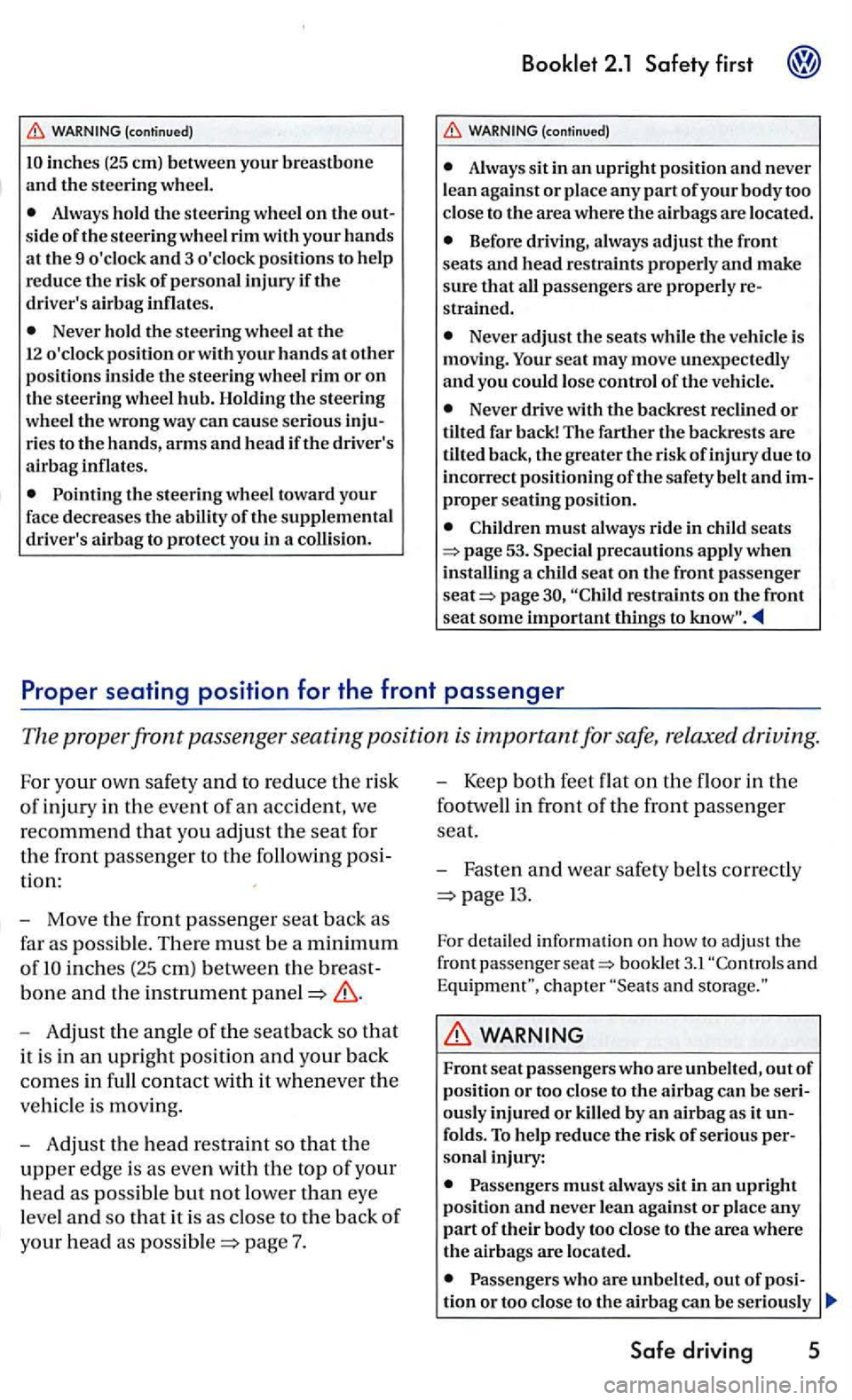
inches (25 em) between your breastbone and the steering wheel.
Always hold the s teering wheel on the
Never hold the steering wheel at the 12 o'clock position or with your hands at other positions inside the steering wheel rim or on the steering wheel hub. Holding the steering
wheel the wrong way can cause serious
2.1 Safety first
(continued)
Always sit in an upright posit i on and never lean against or place any part of your body too
close to the area where the airbags are located.
strained.
Never adjust the seats the vehicl e is mov ing. Your seat may move unexpecte dly and yo u could lose control of the vehicle.
Never drive wit11 the backrest reclined or tilted far back! The fart her t11e backrests are tilted back, the greater the risk of injury due to
incorrect positionin g ofthe safety belt and
Children must always ride in child seats
page restraints on t11e front seat some important things to
Move the front passenger seat back as
far as possible. There must be a minimum
of
Adjust th e angle of the seat back so that
it is in an upright position and your back
comes in full contact with it whenever the
veh icle is moving.
Adjust the head restra int so that the
upper edge is as eve n with the top of your
h
ead as poss ible but not lower than eye
leve l
and so that it is as close to the back of
your head as
Keep both feet flat on the floor in the
footwell in fron t
of the front passenger
seat.
Fasten and wea r safety belt s co rrectly
13.
For detail ed inform ation on how to adju st the
front passenger bookl et 3.1 and s torage.""
WARNING
Front seat passengers who are unbelted, out of posit ion or too close to the airbag can be
risk of serious
Passengers must always sit in an upright position and nev er lean against or place any part of their body too clos e to the area where the airbags are located.
Passengers who are u nbelted, out
Safe driving 5
Page 94 of 444
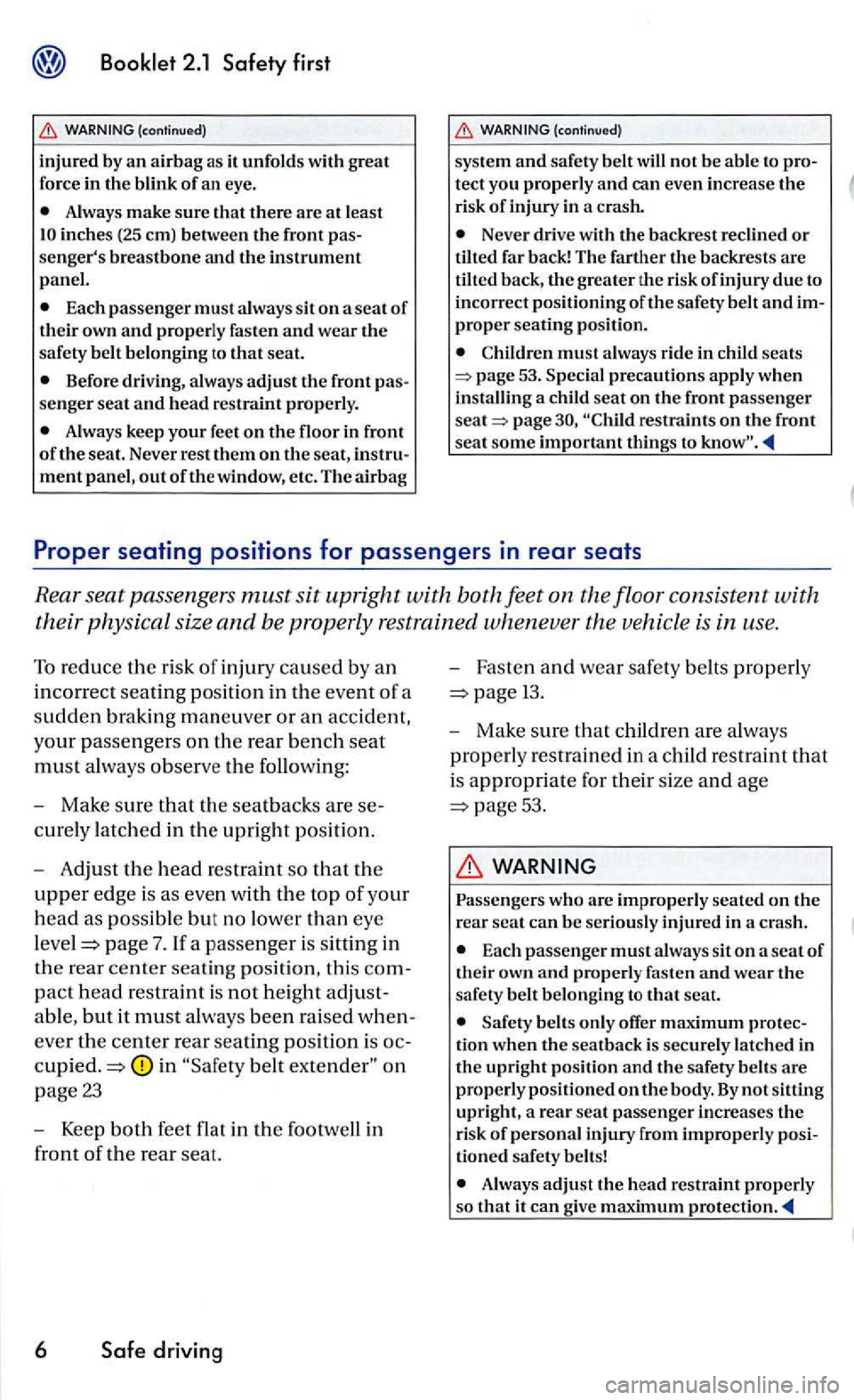
Always make sure that there are at least
Each passenger must always sit on a seat of their own and properly fasten and wear the safety belt be longing to that seat.
Before driving , always adjust the front senger seat and head re straint properly.
Alway s keep your feet on the floor in front of the seat. Never rest them on the seat, ment panel, out of the window, etc. The airbag
tect you properly and can even increa se th e
risk of injury in a crash.
Neve r drive with the backre st recl ined or tilted far back! The farth er the b ackrests are
tilted back, the greater the risk ofinjury due to
in correct positioning of the safety belt and
must always ride in seats 53. a child seat on the front passenger page
Mak e sure that the seatback s are
curel y lat ch ed in the upright position.
A djust th e head restraint so that the
upper edge is as even with the top of your
head as possible but no lower than eye
pag e 7. If a passe nger is s ittin g in
the rear center seating pos ition, this
pac t h ead restra int is not h eight
a ble , but it must always bee n rais ed
eve r the center rear seating posit ion is
belt on
page 23
Keep both feet flat in the footwell in
front
of the rear seat.
6 Safe driving
Fasten and wear safe ty belt s properly
13.
Make sure that children are always
prop e
rly restra in ed in a child re str aint that
is appropriate for thei r size and age
5 3 .
WARNING
Pas sengers who are improperly seated on the rear seat can be se riou sly injure d in a crash.
Each passen ge r must always sit on a seat of th eir own and properly fasten and wear the safety belt belonging to that seat.
belt s only offer maximum tion when the seat back is securely latched in
th e upright po siti on and the safety belts are
properly positioned on the body. By not sitting
upright , a re ar seat pass enger increases the risk of personal injury from improperl y
Always adjust the head restraint properly so that it can give maximum
Page 96 of 444
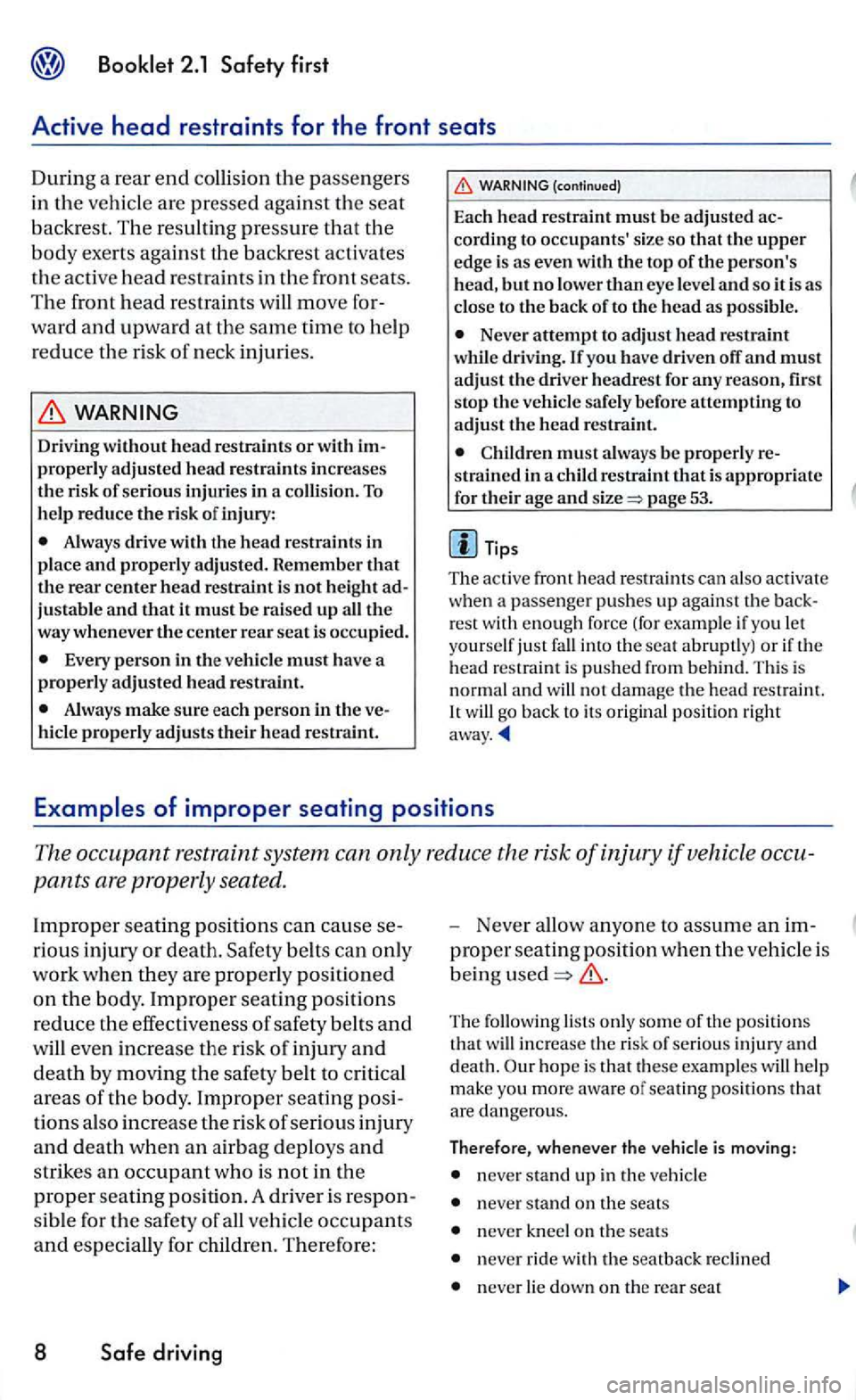
WARNING
Driving head restraint s or with im
properly adjusted head restraints increases
t h e risk of seriou s injuries in a co llision.
To help reduce the risk of injury:
Always drive with the head restraints in
place and properly adjusted. Remember that the rear center head restraint is not height ad
justable and that it must be rai sed up all the way whenever the center rear seat is occupied.
Every person in the vehicl e must have a
properly adjusted head restraint.
Always make sure each person in th e ve
hicle properly adjusts their head restraint.
Neve r attempt to adjust head restraint while driving. If you have driven off and must
adju st the driver headres t for any reason, first
stop the vehicl e sa fely before attempting to adjust th e head restraint.
Childre n must always be properly re
stra ined in a child restraint that is appropriate
for their age and page 53.
Tips
The active front hea d restr aint s ca n al so activate
w he n a passenge r pushe s up again st the backrest with enou gh force (for exampl e if yo u let
yourse lf ju st fall into the seat abruptly) or if th e
h ead restraint is pu shed from behind . Th is is
no rmal and
will not damage the he ad rest ra int. It will go back to it s origina l posit ion right
The followin g lists only some of th e pos ition s
that will increase the risk of seriou s injury and
death.
n eve r stand up in the vehicl e
neve r stand on th e sea ts
n eve r knee l on the seat s
neve r lie do wn on th e rear seat
Page 106 of 444
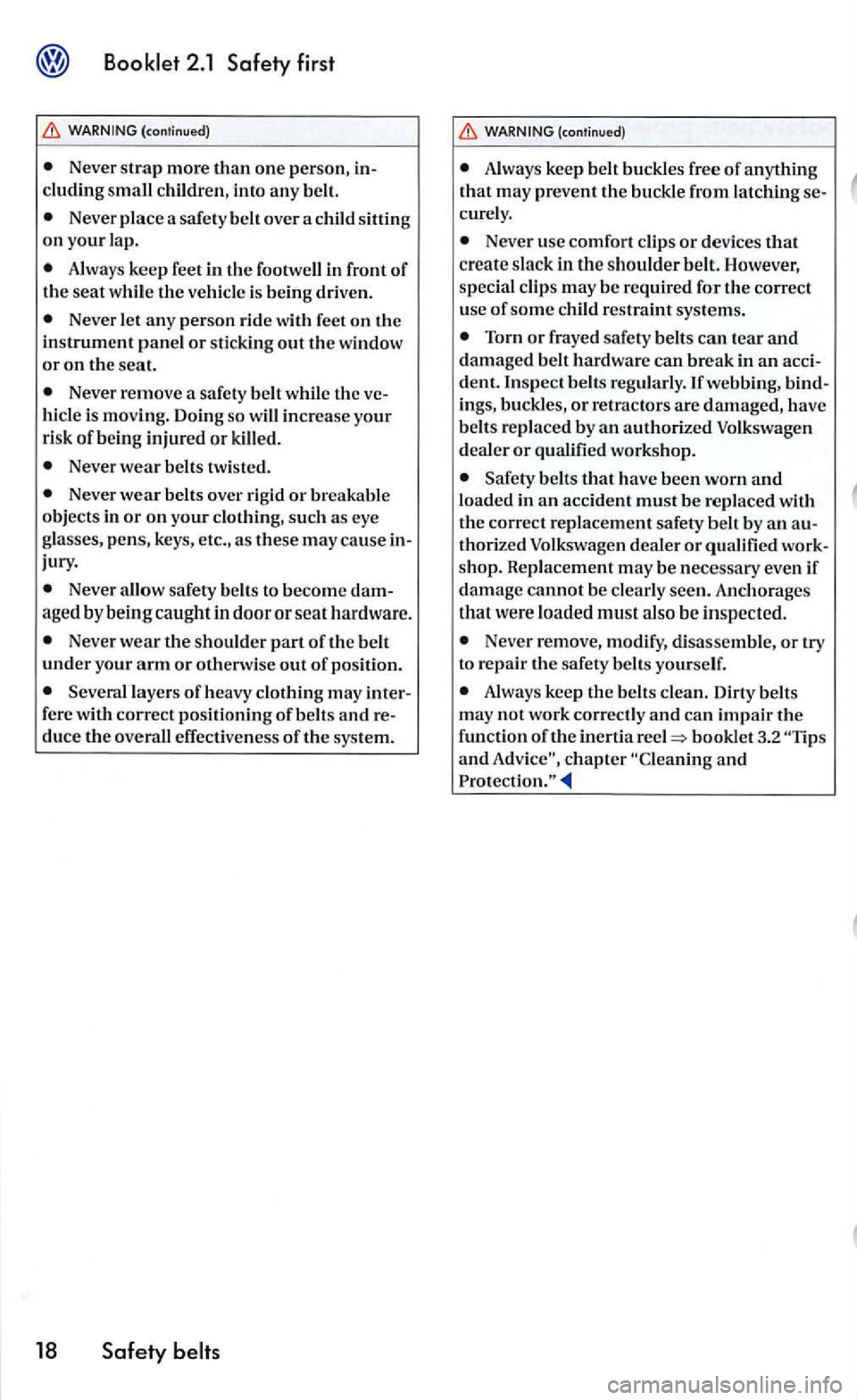
2.1 Safety first
Never strap more than one person, in
cluding c hildren, into any belt.
Never place a safety belt over a child sittin g on your lap.
• Always keep feet in
the footwell in front of the seat while the vehicle is being driven.
Never let any person ride with feet on the instrument panel or sticking out the window or on the seat.
Never remove a safety belt while the ve
hicle is moving. Doing so will increase your
risk of being injured or killed.
Never wear belt s twisted.
Never wear belt s over rigid or breakable
objects in or on your clothing, such as eye
glasses, pens, keys, etc., as these may cause injury.
Never allow safety belts to become damaged by being caught in door or seat hardware.
Never wear the shoulder part of the belt under your arm or othenvise out of position.
Several layers of heavy clothing may inter
fere with correc t positioni11g of belts and reduce the overall effectiveness of the sys tem.
18 Safety
(continu ed)
Always keep belt buckles free of anything
that may preven t the buckle from latch ing se
cure ly.
Neve r use comfort clips or devices that create slack in the sh oulder belt. However,
specia l clips may be required for the correct
use of some c hild restraint systems.
Torn or frayed safety belts can tear and damaged belt hardware can break in an accident.lnspect belts regularly. If webbing, bind
ings, buckles, or retractors are damaged, have
be lts replaced by an authorized Volkswagen
dealer or qualified workshop.
Safety belts that have been worn and loaded in an accident must be replaced with the correc t rep lacement safety belt by an authorized Volkswagen dealer or qualified work
s h op. Replacement may be necessary even if damage cannot be clearly seen. Anchorag es
that were loaded must a lso be inspected.
Never remove, modify, disassem ble, or try
to repair the safety belts yourself.
Alwa ys keep the belts clean. Dirty belts
may not work correct ly and can impair t11e func tion of inertia reel booklet 3.2 and
Page 111 of 444
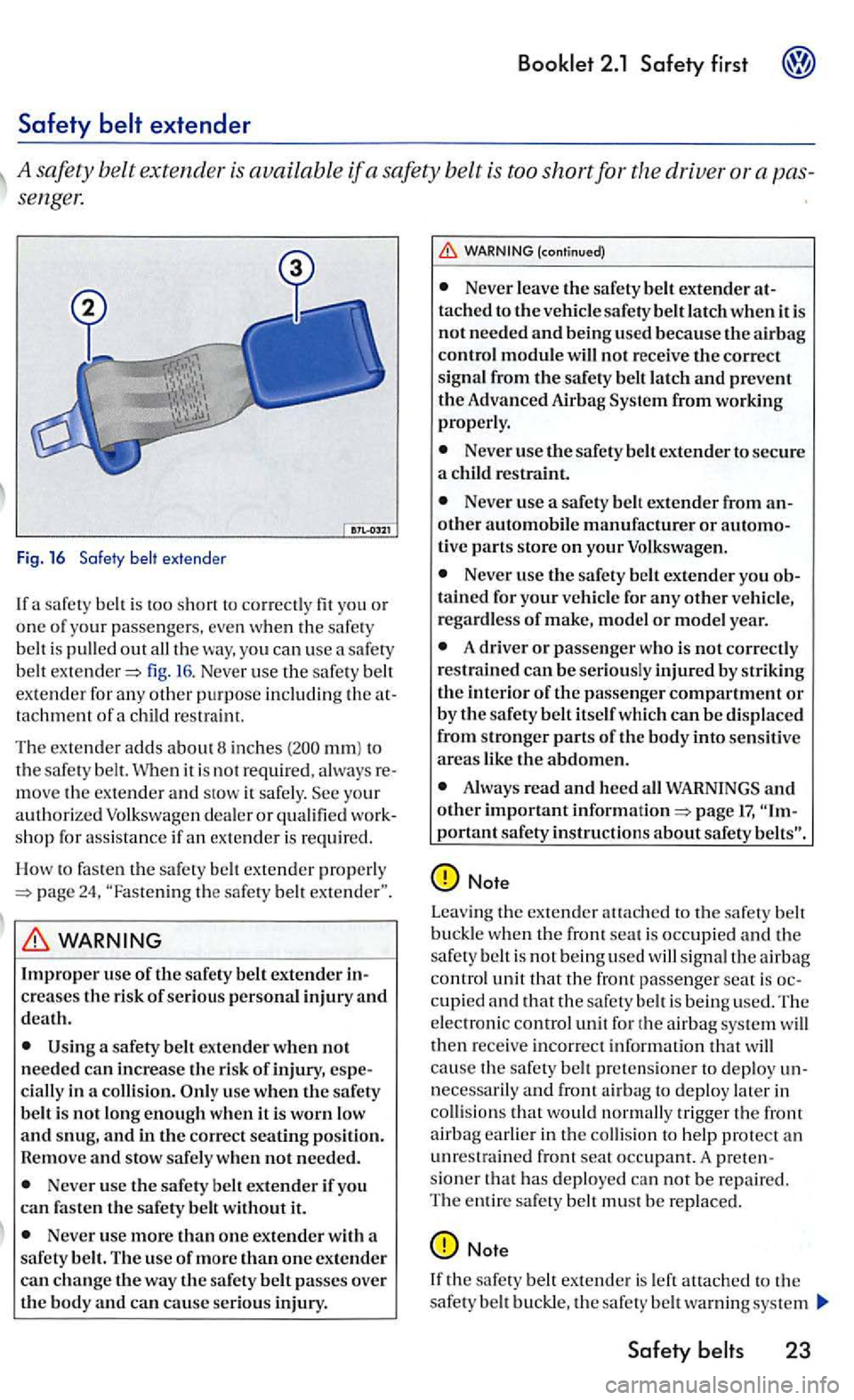
Safety
sengel:
Fig. 16 Safe ty
out fig . 16 . Never use th e safe ty belt
ex tende r for any oth er purpo se includin g th e tachment of a c hild restraint.
Th e
exte nder adds a boutB inches mm) to
the safery belt. Whe n it is not require d , always
s hop for a ss is tan ce if an extende r is requ ired .
H ow to fas te n the s
afety belt extender properly 24, th e sa fe ty belt
crea ses the risk of seriou s personal injury and death.
a safery belt exten de r w hen not needed can increase the risk of injury , cially in a collision. it is worn low
and snug, and in the cor rec t seating position.
R emove and sto w safe ly when not needed.
Never use the safet y belt extender if yo u
ca n fasten the sa fety belt without it.
Never use more than one extender with a
safery be lt. The use of m ore than one extender c a n ch ang e the way the sa fe ty belt passes over
the body and can cause se rious injury .
Never leave the saferybelt extender ta ched to the veh icle safe ty belt latch when it is not needed and being used because th e airbag control module will not re ceive the correc t
s ign al from the safety b elt la tc h and prevent the Advanc ed Airbag from working properly .
Never use the safe ty belt extender to secure
a child restraint.
Never use a safery belt ex tender from
Nev er u se the safery belt extend er yo u tained for your vehicle for any other vehicle,
regardless of make, model or model year.
A driver or pass enger w ho is not correct ly
re strained can be seriously injured b y striki ng the interior of the passe ng er compartment or by the safery b elt its elf whi ch can b e di spla ced
from stronger parts of the body into se nsiti ve areas lik e th e abdomen.
Always read and heed all WARNINGS and other important pa ge
signal th e airbag
co ntrol unit that the front passenge r seat is
ca use the s afery belt prete nsio n er to deploy necessarily and fron t to deplo y la ter in
collision s th at would trigge r the front
a irb ag earlie r in th e to help pro tect an unrestrain ed front seat occ upant. A sioner that has dep loyed can not b e repair ed.
T he entire sa fety belt mu st b e rep laced.
Safety
Page 118 of 444
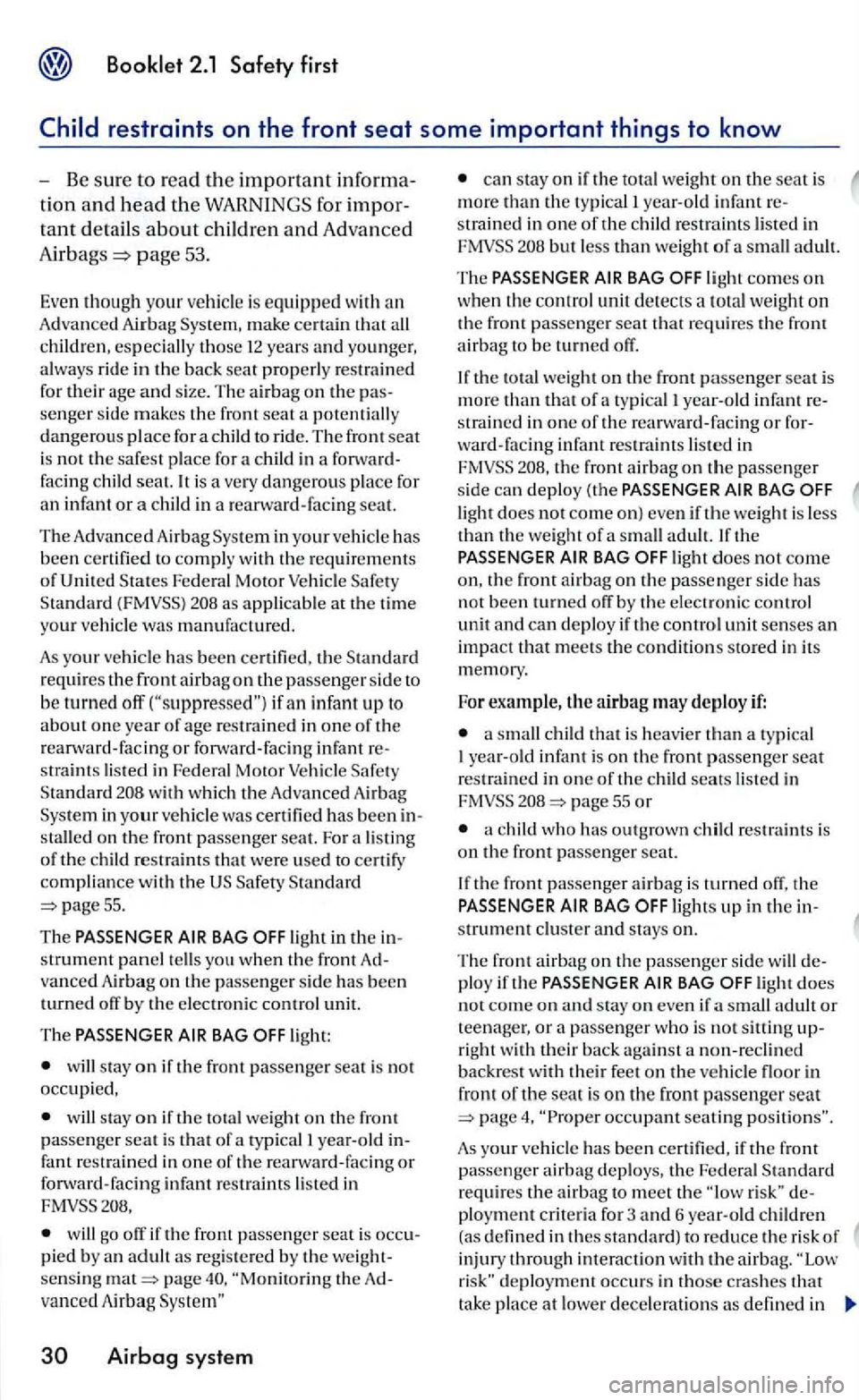
page 53.
Eve n though your vehicl e is equipped wit h an Advanced Airbag System, make certain that all childre n , especially those 12 years and younger, a lways ride in the back seat properly restrained for their
if an infant up to about one year of age restrained in on e of the rearward-fac ing or forward-facing infant re
straints lis ted in Federal Mo tor Standard 208 with which the Advanced Airbag Sys te m in your was certified has been installed on the front passenger seat. For a listing of the child restraints that were used certify compli ance with the
55.
The PASSENGER
will stay on if the front passenger seat is not occupied,
will stay o n if the tot al weight o n the front passenger seat is that of a typical year-o ld infant restrain ed in one of th e rearward-facing or forward-fa cing infant restraints listed in
w ill go off if the front passenger seat is occupied by a n adult as re gis te red by the weightsen sin g page 40,
can stay on if the weight on the seat is more than th e typical! year-o ld infant re-
strained i n one of the child restraints li sted in 208 but less than weigh t of a small
the total weigh t on the front passenger seat is more tha n that of a typica l
208, the front airbag on the passenger side can deploy (the PASSENGER
light does not come on) even if the weight is less than the weight of a small adult. I f the PASSENGER light does not come o n, th e front airbag o n the passenger side has not been turned off by th e e lectronic control unit and can deploy if the control unit senses an impact that meets the conditions stored in its
memory.
For example, the airbag may deploy if:
a small chil d that is heavie r than a typical year-old infant is on the front passenger seat restrained in one of the c hild seats liste d in 20 8 page 55 or
a child who has outgrown child restraints is on the front passenger seat.
If the front passenger airbag is turned off, the PASSENGER and sta ys on.
The front airbag on the passenger sid e w ill deplo y if the PASSENGER BAG lig ht does not come on and sta y on even if a small or teenager, or passenger who is not sitting up
right w ith their back against a non-recl in ed bac kre st with th eir feet on the in
front of the seat i s on the
deployment occurs in those crashes that ta ke place at lowe r decelera ti o ns as defined in